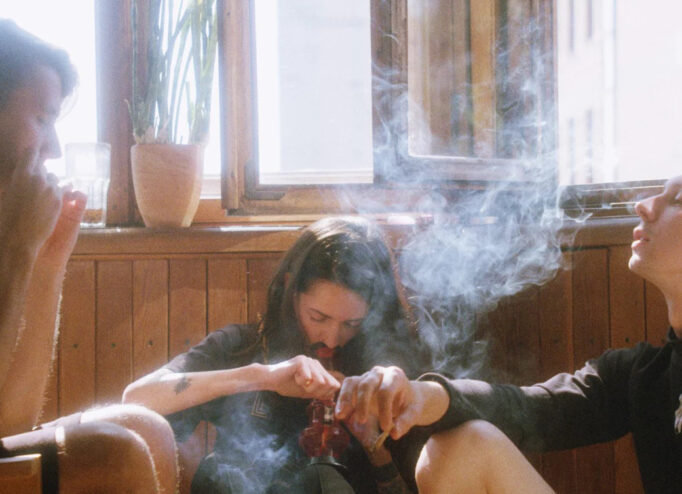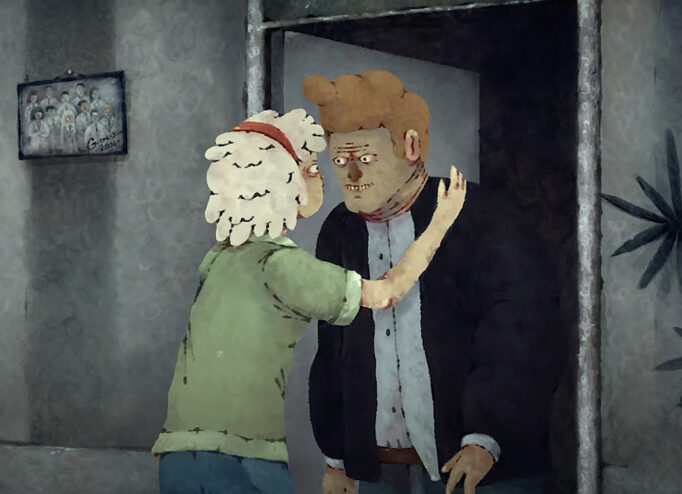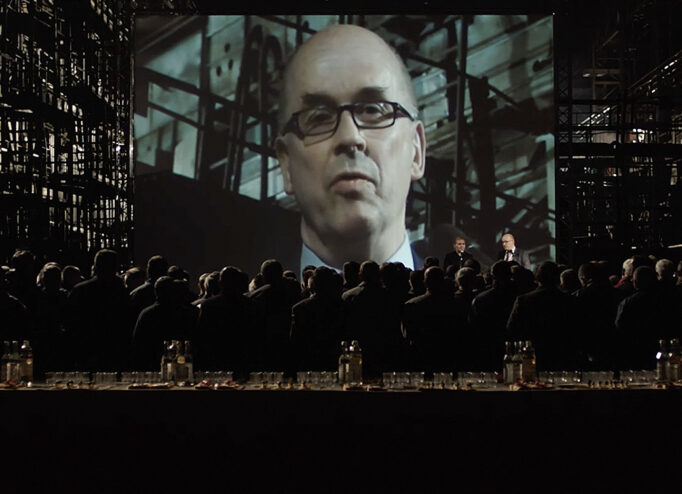Director Maciek Hamela had been volunteering and transporting Ukrainians from the east to the border with Poland since the beginning of the full-scale invasion. Then, together with the cinematographers, they filmed the stories of the temporarily displaced people who sat in the back of their car. That’s how the film “In the Rearview” was created. This is the only full-length film co-produced by Ukraine, Poland and France, which was shown in the ACID (Association for the Distribution of Independent Cinema) programme of the Cannes Film Festival.
“In the Rearvie” won the best Polish film award at the Millennium docs against gravity in Warsaw, and will also take part in the international competition at Sheffield DocFest, the largest documentary film festival in the UK.
In an interview with DTF Magazine, Maciek Hamela explains why he decided to shoot during the evacuation, what Ukrainian city impressed him with its active life, and how he stopped being a fan of russian culture.
Trailer for the film ‘In the Rearview’ (Poland, France, Ukraine, 2023) by Maciek Hamela
— When did you start volunteering and what motivated you to help Ukraine?
— It was like that with many people in Poland. It was tens of thousands of people who volunteered from the beginning — doing very small things. Many of which I don’t think anybody has ever recognized or been talked about. Because these are very simple things: going to the border, buying stuff, finding flats, bringing people home. They were done to different extents, but really quickly I understood that it’s not something unique to me because I have friends in Ukraine or because I’ve been there, or I know a bit of Ukrainian and Russian. It’s much wider, and it’s really something that electrified the whole society’s involvement.
It’s a feeling that this is a common war. Furthermore, it’s an effort that needs to be undertaken, and so I started from the very first day. At the beginning we were fundraising and at the end of the day I bought my first Van and drove to the border. And this is how it all started — transportation. Then I bought the second Van, then people started giving me cars, calling me that they want to drive with me. We found this network of volunteers from very different cities and backgrounds. Someone organized humanitarian aid, others — accommodation, and I was doing transport.
— This film has a very specific angle: the camera mainly shows the back seats of your car. Did the idea for the film arise at the same time as volunteering?
— Volunteering went first. I let go of all my activities at that time, and the effort was so time-consuming that it was not possible to do anything else. I turned down many offers to work on television, and I was just driving. The idea of the film came at the end of March when I had a hard time driving for many hours and I decided to call a friend who was a cameraman to help me to drive at night. And we took a camera, and I thought that I was witnessing a testimony that is unique. I thought we should try to do something with it parallel.
I wasn’t very sure that we would be able to do anything. It was so hard to imagine that this is going to work, because of so many reasons. It’s hard to shoot during wartime. There’s little time, people are stressed, we don’t know if they are going to agree. We didn’t want to impose the filming on them, so there were questions if this was possible. But one thing I was sure from the very beginning, if we do a film, it has to be a film that will be in second place to the evacuation efforts.
And this is answering your question why the backseat, why this form. It came naturally once we knew that we have this constraint that we are not shooting anything that could slow down the evacuation process. That made it very easy, we could only shoot the departure, the road and the arrival. That’s it. And there were no other possibilities.

Maciek Hamela, director of the film ‘In the Rearview’
— But there were a couple of shots at the Ukrainian posts, where it’s forbidden to shoot. Did you have any problems with that?
— We had many problems everywhere, but we found our way. I don’t want to spoil all the details. What we did is we shot the difficult parts as the posts when we were returning, so we’ve already delivered the people, and we’re on our way back. This is when the cameraman would sit down at the back on the empty seats, and he will be able to shoot the perspective of the people.
— It’s always hard to stop shooting and end the film on a certain note, especially in documentaries. How did you know when to stop?
— I had a hard time stopping. I didn’t want to stop, but it was also coming naturally. The evacuations were less and less frequent. For example, I was working with the organization ‘Vse bude dobre’ that deals with evacuations in the Donbass. They were getting the requests for every day from Chasiv Yar, Soledar and cities around. They went down to having a request once a week for somebody. You spent more time waiting and going around, trying to convince people to leave, than actually driving them out. This was a big change.
At the beginning of the war, my phone was hot from phone calls. Literally, I would have twenty attending phone calls simultaneously. People were just calling me and from this we went down to the villages around Soledar under shelling, with no gas, no electricity, no water.
30 families are still living there, and you have to talk to them, and they still don’t want to go because they say: «Nobody wants us there. We don’t have family in western Ukraine. Here’s our house».
It was a big process. I realized I have to move to Ukraine permanently if I want to do these evacuations. So that was the first thing. Also the film helped me come out of this. When I came back, I had a hard time coming back to daily life. The film helped me to turn my focus into something important as well. This film has its own kind of mission. Just like I had a mission at the beginning with thousands of people like me.
Now with the film we have a different mission. We try to reach more people, tell them that the war is still going on, maybe they just could imagine themselves on the spot, on the empty seat at the end of the film. Maybe they’ll join and help out in some possible way. Maybe we will reach for those who are not yet done anything, because they didn’t think this was concerning them.

A still from the movie ‘In the Rearview’
— There’s a wide discussion that all Ukrainians received a collective trauma because of the war. And you said that this film helped you come back to daily life. Did you consider that this film serves you as psychological recovery after all you’ve been through?
— I’m not a psychologist, although I have a family of psychologists. My sister and mother are psychologists, and my mother’s sister is a psychologist. And I did study psychology for a year, but I’m not an expert in trauma. Of course, we went for some harsh moments that are not in the film. We were under artillery fire, and we decided to leave it out of the film. This film is about something else. There are a lot of films that are coming out from the war in Ukraine where there is much more fighting, shelling, and bullets flying. We did not want to compare the dangers we encounter and the Ukrainian soldiers encounter every day.
For me, that was important to make a film that is about something else. But I personally think that this film helped me to get out of this very hard experience and have a soft landing back in my life. When I came back, I had a hard time going to cafés and meeting with friends who had no idea what we’ve been through.
If you think of such a city as Dnipro, which is very close to the war. It was for a very long time not even bombed. It was spared from the bombings, and the cafés never stopped working there. People never stopped going on the Saturday morning walk around the Dnipro river, and all the bars there were working non-stop, even in March. And it’s so close to Donbas. You understand that life is stronger than death. This film is also a little bit about that.
The war should not become a part of our ordinary lives. But ordinary life always takes over, so if the war doesn’t disappear, it will be incorporated into ordinary day life. We will somehow get used to it.
This will forever be a part of me and my experience, and I have to accept that. I don’t call it a trauma, I call it a different level of experience, of going further. To be honest, if you volunteer in the train station in Przemyśl and you were exposed to all the drama of the people arriving there, it’s just as traumatizing, because it’s this tragedy that you’re feeling left to deal with alone. You can’t change a lot. You can change maybe 0.0001%. You can’t do basically anything, and that’s also traumatizing.
— You’ve been to Soledar and other villages of Donbass before they were occupied. Do you have different feelings when you watch the film with these places now?
— Yes, definitely. Soledar, Rozdolivka, Fedorivka — all these villages on the road to Siversk, which are now on the grey zone or occupied, I often think about what has happened to these houses, but mostly I think about the families that I wasn’t able to convince leaving and there are many. I don’t know what has happened to them. There were just so many and they were so reluctant to leave. It sometimes comes back to my mind when I think of that area that has seen so much fighting.
Last time I was in Bakhmut, there was one guy that I met who had 2 restaurants and a few stores. His wife had a store with food for animals. He let his family leave to the western Ukraine, but he stayed and that was the only thing that was opened — this cat food place — and he was there, because he still had clients who were coming to buy the cat food, because all these babushkas, who stayed, had more cats that they had to carry, because people left their pets behind. So there was a huge demand for cat food and I went there to buy cat food also. I think about this guy and the clients of the store very often — what happened to them, I don’t know.

A still from the movie ‘In the Rearview’
— Before the Revolution of Dignity, you were an admirer of Russian culture and now you don’t. Why do you think it still has such a powerful influence on the Western world despite its use as one of the tools of war?
— I think the war has changed a lot. This influence is going to diminish with the war. It’s maybe not the right moment to talk about what we like in Nabokov or Dostoevsky. It’s not the right time to talk about Russian culture in general. Likewise, it’s a good moment to keep it out of the spotlight.
Of course, Russian literature has had a huge influence on France especially since the 18th century, and it’s very visible. I would set some things apart. There’s Russian culture and how it’s incorporated in Ukraine, which comes with Ukrainian-Russian problematics, which we in Poland understand. As well as in Latvia, Georgia, Estonia.
In France, this stuff is completely irrelevant. Nobody talks about it, and it’s abstract, because people don’t know what Dostoevsky’s take on Ukraine and Ukrainian language was. It’s our Ukrainian perspective that we share in Eastern Europe, because we know how this starts. You start by this, and then you’ll come with the tanks into the country by saying your country shouldn’t exist. We know this, but if you don’t go through this, this is not a part of the culture you’re incorporated in. I think it’s right to be shocked and there’s should be a talk about like this.
— So do you support the banning of russian culture by the Ukrainian film community?
— I think we as a European community should right now take russia out of the spotlight. Everywhere. It’s not even culture. And for very pragmatic reasons. That’s not because I think that all russians are supporters of putin. It’s about pragmatics. For cinema, it’s very simple. Ukrainian filmmakers don’t have support that they could have. They could not compete on the same level, because they don’t have money to make films right now. They are taken out of the game and their voice is not present. It’s important to put in place special funds for Ukraine, and had a little speech about supporting Ukrainian filmmakers.
Serebrennikov coming to Cannes last year was a great example. He came to Cannes and talked about how russian soldiers are the victims. This is spreading Russian propaganda.
At the end, somebody waves the hand and says it’s complicated. And you don’t know which side to be on. What happened last year with Serebrennikov was an outrage’s scandal. I don’t support a total ban on culture, but I think it should be completely taken out of the spotlight.

A still from the movie ‘In the Rearview’
— When will your film be screened in Ukraine?
— This film for sure will be screened in Ukraine. We don’t know the date yet. Ukrainian producer Anna Palenchuk is taking care of it. Right now, the importance of the film is to show it elsewhere, so that experience shared by so many Ukrainians is also shared with the audience of the Western Europe and the other side of our planet.
— Do you have anything on the plate to work on?
— I have a few projects ahead — one in Poland, one in Ukraine and one in Africa in different stages of development. We just finished the film and I need to take a little bit of deep breath after this long process. We have a lot of festivals coming up and a lot of work around this film, so this is what we’re focusing on right now.






